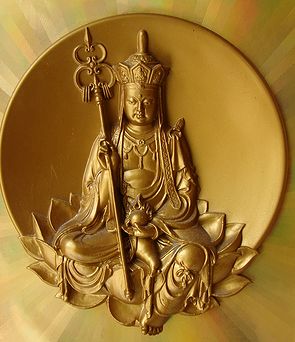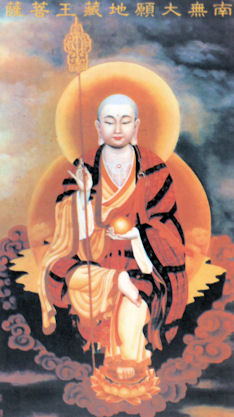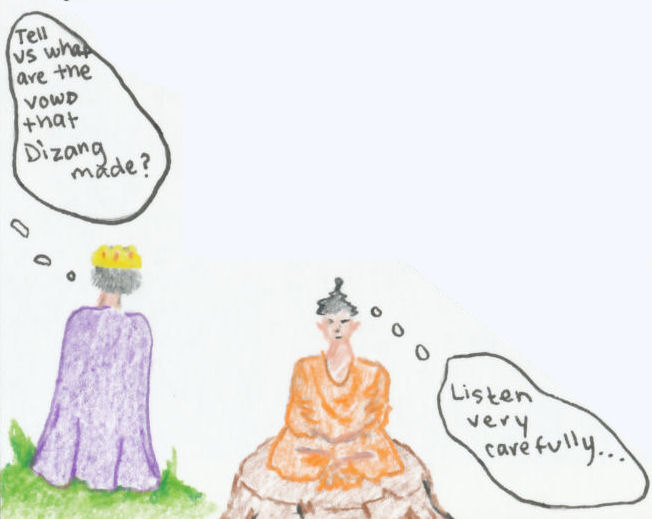
Content created: 2010-08-23
File last modified:


This brief reading is made up of slightly over half of chapter 4 of a scripture called the “Fundamental Vows of the Ksitigarbha Bodhisattva” (Dìzàng Púsà Běnyuàn Jīng 地藏菩萨本愿经)

This scripture is one of the most popular in the Chinese Buddhist canon, and it is considered the locus classicus on hell and its horrors. They are partially enumerated in chapter 5, but are far more elaborately drawn out in popular texts like Jade Guidebook (Yùlì Bǎochǎo 玉历宝钞), translated elsewhere on this web site (link).
More importantly, it is the primary scripture detailing escape from hell through the extension of merit by the merciful Dìzàng. It tells us who he is, and how he comes to be so important.
As far as I know, we lack the Sanskrit original of this work. The Chinese text was among those translated into Chinese in the late 600s by a monk from Khotan (Hétián 和田) in western Xīnjiāng 新疆 named Śikṣānanda in Sanskrit, Shíchā-nántuó 实叉难陀 in Chinese).

The text recounts a visit by the Śākyamuni Buddha (Shìjiāmóuní fó 释迦牟尼佛) to the so-called Trāyastriṃśa Heaven, where a variety of supernatural beings are assembled. The visit is intended to bring his teachings to his deceased mother, who also dwells here. (Tradition holds that the same visit for the same purpose was also made by other buddhas.)
However it is also an occasion to appoint the bodhisattva Dìzàng wáng 地藏王 (Kṣitigarbha) to look after humanity after Sakyamuni’s death and before the arrival of the buddha of the future, Maitreya (Mílè 弥勒).
The name Dìzàng (like Kṣitigarbha) means “earth treasury,” and refers to his accepting a position overseeing the dark realms of the dead in hope of liberating souls from suffering insofar as their karmic balances will allow. He is appropriate for the task because of the great merit he has acquired over many incarnations, but at the beginning of our extract this fact is still unknown to some of the other figures in the assembly.
Chapter 4 (and hence our extract) begins with Sakyamuni heaping praise upon Dìzàng , seemingly excessively, for the many virtuous vows he has taken. Others wonder what is so special about Dìzàng. Finally this embarrassing and seemingly slightly ungenerous question is put by a prestigious “Great Being” (mahāsattva, or móhésà 摩诃萨) among them, namely a bodhisattva known by the title “King of Self-Mastery (Dìngzìzài wáng 定自在王),” who broaches the subject as politely as possible, addressing the Buddha as “World-Honored One.”

In answer to the king’s question, the Sakyamuni Buddha describes Dìzàng’s vows and merit. The two stories he relates in our extract involve past incarnations of Dìzàng, but are sometimes taken as independent (even competing) stories of his life on earth. Indeed, in the 1960s the second one of them became a full-length motion picture (called “The Saviour Monk” in English, “Dìzàng Wáng” 地藏王 in Chinese).
To simplify presentation here, lines are numbered to facilitate class discussion, and the text is divided into arbitrary “pages” to which I have added titles.
The engaging pictures illustrating the story are from three of the students in my UCSD class on Chinese popular religion in Winter, 2016.
On page 1 we join the conversation in progress as the King of Self-Mastery asks his embarrassing question.
One technical point: On page 5 reference is made to “foul paths” (èdào 恶道). Custom differentiates six paths of reincarnation after leaving the torments of hell. In the text, the “foul” paths are the three worst, and include returning to constant torment in hell, rebirth as an animal, and rebirth as a tattered beggar. Artistic representations, in contrast, usually populate the six paths differently, with 4 kinds of animals and two of humans, for example.
The Chinese text used here can be found on-line at the web site of the Chinese Buddhist Electronic Text Association 電子佛典協會 (Main Link, this text). This extract runs from line T13n0412_p0780b29(06) through T13n0412_p0781b17(02). Although I have retained their quotation marks, I have replaced other punctuation with the more traditional punctuation used by Shì 1975: 280-285. (In one case I have repunctuated the line following Anonymous 1995, from which the top illustration on each page was also taken.)
A full translation of the entire scripture, with a religious commentary, was published in book form as Anonymous 1974, which is available in a slight revision at the web site of the Sagely City of Ten Thousand Buddhas (main link, this text).
Another full translation, although in my view an infelicitous one, is available at the web site of the Buddhism Study & Practice Group of SUNY Stony Brook (main link, this text).
A wikipedia page introducing the scripture is characteristically informative (link).
Dìzàng figures in various popular stories. A particularly prominent one, because it has inspired the representation of two subordinates shown beside him in art, is "The Tale of Duke Mǐn 闵公 & Dàomíng 道明," which is not set in the underworld, but in the mountains of Ānhuī 安徽 Province. (Story Link)
Return to top.
Go to
next file.